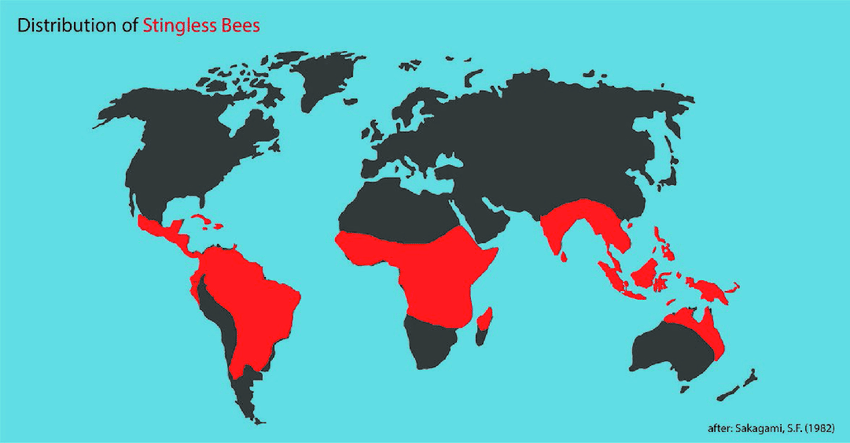Bees play a crucial role in pollination and biodiversity, but not all bees are the same. While honeybees (Apis species) are well-known for honey production, stingless bees (Meliponini tribe) are gaining attention for their unique ecological benefits and medicinal honey. Meliponiculture, the practice of raising stingless bees, is becoming increasingly popular, especially in tropical and subtropical regions.
This article explores the fascinating world of meliponiculture, its benefits, methods, and its growing significance in sustainable agriculture.
What is Meliponiculture?
Meliponiculture is the cultivation and management of stingless bees (Meliponini) for honey production, pollination services, and conservation. Unlike traditional beekeeping (apiculture), meliponiculture involves bees that:
✅ Do not sting, making them safer to handle
✅ Are highly efficient pollinators for native plants and crops
✅ Produce unique medicinal honey, highly valued in traditional medicine
✅ Are adapted to tropical and subtropical climates
Stingless bees are found in Latin America, Africa, Asia, and Australia, making meliponiculture a sustainable alternative to traditional beekeeping in these regions.
Benefits of Meliponiculture
🐝 High-Quality Medicinal Honey
Stingless bee honey, known as “pot-honey,” is prized for its antibacterial, antifungal, and antioxidant properties. It has been used in traditional medicine for treating wounds, respiratory diseases, and digestive disorders.
🌿 Superior Pollination Services
Meliponines are better pollinators than honeybees for many tropical plants, helping increase fruit yield and quality for crops like:
✔️ Passion fruit
✔️ Coffee
✔️ Mango
✔️ Avocado
✔️ Cocoa
🌍 Conservation & Biodiversity
Meliponiculture helps protect native bee species from habitat destruction and pesticide use, promoting ecosystem balance.
🏡 Ideal for Urban & Small-Scale Beekeeping
Since stingless bees do not sting, they are safe for homes, schools, and urban farms. Small-scale meliponiculture is perfect for backyard beekeepers and agroforestry systems.
How to Start Meliponiculture
🏠 1. Choosing the Right Stingless Bee Species
Different species thrive in different environments. Some popular stingless bees for meliponiculture include:
- Melipona beecheii (Mayan stingless bee) – Mesoamerica
- Tetragonisca angustula (“Jataí” bee) – South America
- Trigona carbonaria – Australia
- Heterotrigona itama – Southeast Asia
📦 2. Selecting the Hive
Traditional log hives or modern modular wooden hives can be used. Meliponiculture hives typically include:
✔️ Brood chamber (for eggs & larvae)
✔️ Honey storage pots (for harvesting)
✔️ A protected entrance (to prevent predators)
🌱 3. Hive Placement
Hives should be sheltered from direct sunlight, wind, and rain. They can be placed in:
✔️ Forests
✔️ Home gardens
✔️ Greenhouses
✔️ Rooftop farms
🍯 4. Harvesting & Honey Production
Unlike honeybees, stingless bees store honey in small resin pots rather than wax combs. Honey is collected manually, and hives should be managed carefully to ensure colony health.
🛑 5. Protection Against Threats
Stingless bee colonies are vulnerable to pests, habitat loss, and pesticide exposure. Using organic farming practices and proper hive management ensures their survival.
Growing Interest in Meliponiculture
Governments, researchers, and conservationists are promoting meliponiculture as a sustainable alternative to traditional honey production. Some countries have subsidy programs for stingless bee farmers, and scientific studies continue to explore their role in crop pollination and biodiversity conservation.
In regions like Brazil, Mexico, Australia, and Indonesia, stingless beekeeping is now a booming industry, with high-value honey and eco-tourism initiatives supporting rural economies.
Conclusion
Meliponiculture is more than just beekeeping—it is an eco-friendly, profitable, and conservation-driven practice. As interest in sustainable agriculture, biodiversity conservation, and medicinal honey grows, meliponiculture offers a promising future for beekeepers, farmers, and nature lovers worldwide. 🐝🌍🍯

Species richness of stingless bees (Hymenoptera: Apidae: Meliponini) have 28 genera with 259 valid species and 62 undescribed species. This image shows numbers of in each state within Brazil. An amazing variety supporting ecosystem health and immense commercial opportunity.
